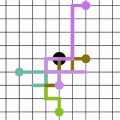In this paper, we use analysis on graphs to study quantitative measures of segregation. We focus on a classical statistic from the geography and urban sociology literature known as Moran's I score. Our results characterizing the extremal behavior of I illustrate the important role of the underlying graph geometry and degree distribution in interpreting the score. This leads to caveats for users about the usefulness of I for making comparisons across different localities. We present a novel random walk interpretation of I, connecting the measured level of segregation to the rate of variance reduction via diffusion. Concerns about interpretability of I lead us to propose an H^1-norm on graphs as an alternative measure of segregation, enabling connections with the literature on community detection in networks and high- and low-frequency graph Fourier modes. Our methods outline a new program for the study of geographic segregation that is motivated by time-frequency analysis on graphs. We offer illustrations of our theoretical results with a mix of stylized synthetic examples and graphs derived from real geographic and demographic data.
翻译:在本文中,我们使用图表分析来研究隔离的量化计量。 我们侧重于来自地理和城市社会学文献的古典统计,称为Moran's I 得分。 我们从我极端行为中得出的结果说明了基本图形几何和度分布在解释得分方面的重要作用。 这导致用户对I在不同地点进行比较的有用性提出告诫。 我们对I作了一种新颖的随机步行解释,将测量到的隔离程度与通过扩散减少差异的速度联系起来。我对图表的可解释性的关切导致我们提议在图表上设置一个H1-诺姆,作为隔离的替代措施,使在网络和高频和低频图四流模式中与社区探测的文献建立联系。我们的方法概述了由对图表的时间频率分析所推动的地理隔离研究新方案。我们用从真实地理和人口数据中得出的标准合成示例和图表混合了我们理论结果的插图解。




